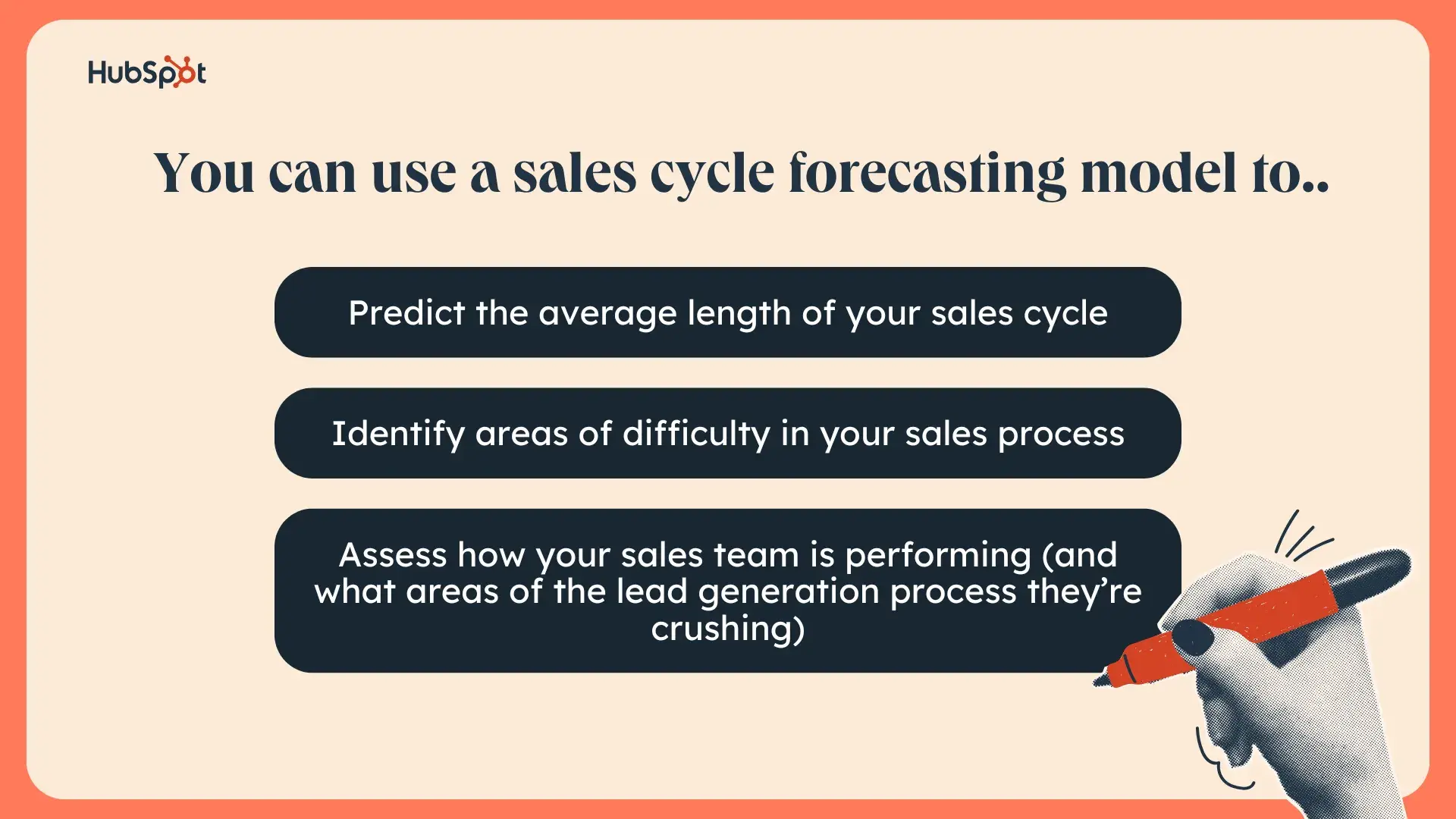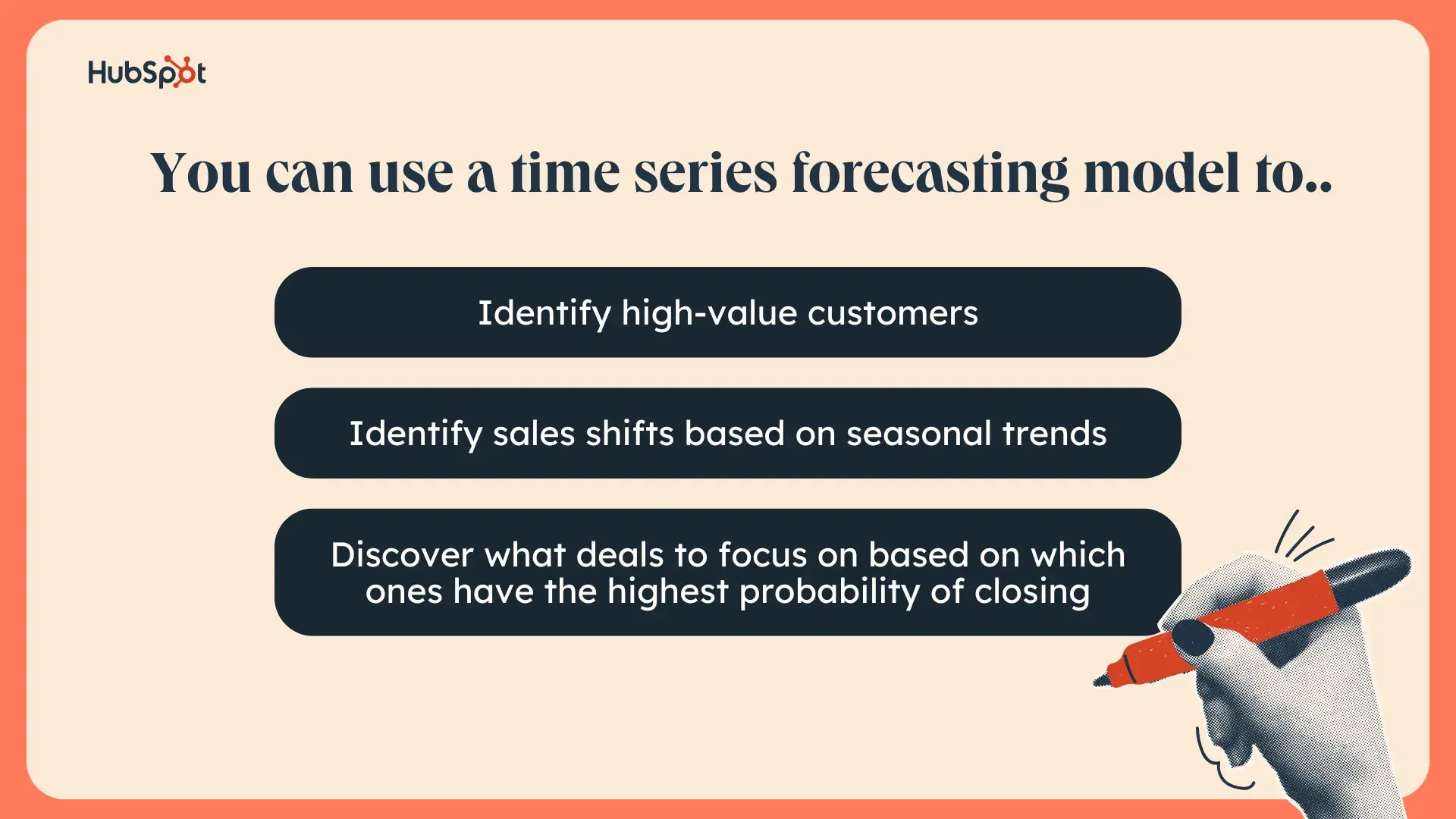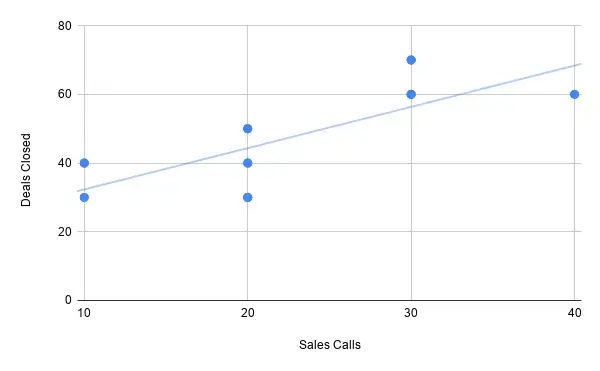Leaning on forecasting models is a necessary – sometimes tricky – part of preparing for the upcoming fiscal year, especially for my sales folks.
You see, if you work in sales, you already know that you can't use a crystal ball to predict the future (even if you’re expected to), so you’re left analyzing quantitative (and sometimes qualitative) data to anticipate future leads, revenue, and profitability.
In short, even with forecasting models on your side, sales forecasting is a guessing game that can be a real headache, especially if you’re working with little data. And I get that.
In this article, I’ll break down a few tried and true strategies and tactics you can use in your next sales forecast to not only better predict your successes for next year but also to make well-informed decisions for your sales team.
Table of Contents:
- What is strategic forecasting?
- "What is a forecasting model?"
- Types of Forecasting Models
- How to Improve Your Sales Forecasting
- Forecasting Models and Fate Aren’t The Same

What is strategic forecasting?
In marketing and sales, strategic forecasting is the use of benchmarks, historical data, and other information and factors to make predictions about future demand and sales growth.
What is strategic forecasting?
In marketing and sales, strategic forecasting is the use of benchmarks, historical data, and other information and factors to make predictions about future demand and sales growth.
Before I lay ground on how to use forecasting models in sales, it’s important to set the record straight: Sales forecasting is useful, but it’s nothing without a data-informed strategy. Sometimes, the misconception of what sales forecasting actually means (and, therefore, what it actually reveals) creates disappointment among sales teams down the road.
.png)
Free Sales Conversion Rate Template
Easily calculate drop-off rates and learn how to increase conversion and close rates.
- Dropoff and Conversion Rate Calculator
- Monthly & Quarterly Sales Goal Setting Template
- Deal and MRR Pipeline Tracker
Download Free
All fields are required.
.png)
Instead, it’s better to think about sales forecasting in this way: Sales forecasting should be used to identify and exceed realistic targets based on solid data. Otherwise, you’ll be severely disappointed when you’re unable to accurately measure revenue targets, progress, or other important KPIs.
Now that I got the fundamentals out of the way, let’s talk about how you – and most sales professionals – can do all of the things I just mentioned, all by using forecasting models.

What is a forecasting model?
A forecasting model is a tool that business leaders use to anticipate sales, revenue, leads, new customers, supply and demand, and other core functions using historical data about the business. Annual goals are set based on the information produced by the forecasting model. Without a forecasting model, these predictions would be arbitrary and could result in the team missing the set goals.
What is a forecasting model?
A forecasting model is a tool that business leaders use to anticipate sales, revenue, leads, new customers, supply and demand, and other core functions using historical data about the business. Annual goals are set based on the information produced by the forecasting model. Without a forecasting model, these predictions would be arbitrary and could result in the team missing the set goals.
Now, don’t get me wrong: Forecasting models are pretty darn handy. However, there is no one-size-fits-all forecasting model, though. When it comes to high-performing sales teams, you'll need to choose the right model (or combination of models) to create a fair and accurate annual goal.
Check out some of these popular forecasting models below. While all of them can't be used for sales on their own, you use the information you gather from them to help inform your sales forecast:
Types of Forecasting Models
1. Length of Sales Cycle Forecasting Model

An important factor for every sales rep (no matter their industry) is the length of the sales cycle. Essentially, this type of forecasting model represents the time it takes for a prospect to pass through every stage in the sales cycle, from lead all the way to repeat buyer.
Understanding the length of your sales cycle, then factoring that into your sales forecast, will help your sales team focus on closing deals rather than rushing prospects through the process in order to beat the clock each month.
Consider the length of your sales cycle as a fixed metric. Unless your sales leadership team has plans in place to speed the cycle up, go ahead and assume that the length of the sales cycle won't change.
2. Time Series Forecasting Model

If you can't tell by now, using historical data to forecast for the future is a theme in many of these forecasting models, but time series forecasting focuses primarily on historical data without the use of other variables.
With this type of forecasting model, your sales will be plotted on a line graph, with each point representing a specific point in time. You can use time series forecasting to predict when future sales might happen based on when sales have happened in the past.
3. Demand Forecasting Model

There are a few different types of demand forecasting models that focus on internal and external factors that affect demand. To keep things simple, I’ll focus on the two most popular types of demand forecasting: passive and active.
Passive demand forecasting looks at past data to predict future sales. This type of model keeps things simple by only accounting for internal factors that your business can control. However, seasonal trends that your business typically experiences are also taken into account.
Active demand forecasting uses data in real-time (or as close to it as you can get) as possible to forecast future sales. With this type of model, you'll include external factors like the state of the market, marketing strategies that are currently in play, and knowledge of the competition if you have it.
There’s a lot more to get into with passive and active demand forecasting that I won’t do here. But if you're looking for a comprehensive guide on demand forecasting models, check out HubSpot’s complete guide.
4. Regression Forecasting Model

[alt text] image listing reasons for when to use a regression forecasting model
It's time to roll up your sleeves and get hands-on in Excel for this model. A regression model is a statistical process for understanding what independent variables are associated with your dependent variable. In sales terms, a regression model helps you understand how sales activities and closed deals are related.
The formula for a regression model is Y = bX + a, where Y is the dependent variable and X is the independent variable. Values a and b are the y-intercept and slope of the regression line, respectively; don't worry, Excel will take care of a and b in the formula automatically when you supply historical data about your sales.
Check out the image below, where X is the number of sales calls and Y is the dependent variable (number of deals closed):

[alt text] example image of a regression analysis that examines the relationship between sales calls and deals closed
Pro Tip: Statistics do not define causation, only correlation. That means you should supplement the information you glean from the regression forecast model with qualitative data from your sales reps about what activities are the best uses of their time.
.png)
Free Sales Conversion Rate Template
Easily calculate drop-off rates and learn how to increase conversion and close rates.
- Dropoff and Conversion Rate Calculator
- Monthly & Quarterly Sales Goal Setting Template
- Deal and MRR Pipeline Tracker
Download Free
All fields are required.
.png)
Now, if you find that the variables – let’s use the “sales calls” and “deals closed” variables from our example above – are positively correlated (as shown in the analysis pictured). Although it might seem like making more sales calls could cause an increase in the number of deals closed, this relationship could also be influenced by an entirely different third variable, such as product demand.
During peak demand periods, sales reps may increase their call volume due to the greater availability of potential customers. Simultaneously, heightened customer interest can lead to a surge in closed deals. In such scenarios, the underlying factor – elevated product demand – influences both the number of calls made and the number of deals closed, resulting in a correlation between the two without one directly causing the other.
The key to running a helpful regression forecasting model is using historical data and running a regression for each activity. Once you‘ve run your regression model, you’ll be able to see a correlation (or lack thereof) between a specific activity like deals closed and sales calls.
Some additional activities that can affect your sales include the number of outbound calls made, inbound calls received, and demos completed. You can run a regression for each of these independent variables to determine which activities to focus on and which don't matter much in the grand scheme of things.
Most businesses experience some seasonality in their sales, so it’s a great practice to account for this in your sales forecasting. A seasonal forecasting model can reveal exactly how much deviation each month has compared to the annual average.
To use data from a seasonal forecasting model, you'll need to compare the seasonal index, a comparison between a specific seasonal time period to the average seasonal time period, to the average annual sales cycle.
For a detailed tutorial on how to use a seasonal forecasting model, take a look at this video.
How to Improve Your Sales Forecasting
Now, let’s take a look at a few simple tactics that sales teams and executives can use to create better forecasting models for their business:
.png)
Free Sales Conversion Rate Template
Easily calculate drop-off rates and learn how to increase conversion and close rates.
- Dropoff and Conversion Rate Calculator
- Monthly & Quarterly Sales Goal Setting Template
- Deal and MRR Pipeline Tracker
Download Free
All fields are required.
.png)
1. Use historical data.
Most large companies have historical data they can use to determine realistic sales forecasts. If your company hasn’t implemented analytics and other forms of tracking methods that can be tied to goals and conversion rates, get to it ASAP. You need to know where you’ve been so you can accurately forecast where you’re going.
It’s true past sales are not always accurate predictors of future performance. This year, you might release new products, expand into new markets, face an increase in competition, and so on and so forth.
However, historical data is a solid foundation on which you can stand as you weigh additional, unpredictable factors that could increase or decrease sales in the upcoming year. These are scenarios you can weave into your presentation of firm numbers for your final forecast.
2. Keep clean records.
If no clear standards are communicated to the team, sales reps may come up with their own definitions and use cases, leading to inconsistent data entry. Or, if they don't know how important a property is, reps may fail to use it altogether.
You can't make good decisions on dirty data, so for any numbers that aren’t as concrete as sales and revenue — like current deals in the pipeline or number of deals per customer segment — make sure your team is on the same page.
You can do this by:
- Providing ongoing training to the team on CRM use
- Continuously referring to the forecast in team meetings
- Checking up on deals during one-on-one meetings
- Performing spot checks on records and deals to note inconsistencies
3. Start with a simple model.
I know it’s tempting to try and incorporate each of the model types we talked about earlier but resist the urge to do this.
If this is your first time using a quantitative forecasting model to predict sales for the next year, don’t be afraid to start small and improve your model over time.
Using something simple like a regression forecasting model for five of the most common sales activities your team performs is a better model than one that combines seasonality, time series, and demand forecasting into one. Why? Because the fewer variables you have to keep track of, the simpler it will be to:
- Achieve your sales goals.
- Explain to your sales reps why the goals were set this way.
- Get approval from leadership on your forecast.
Once you determine how well your forecast model is working for the first year, you can update it the following year with variables from another type of model.
4. Implement a sales pipeline action plan.
For sales leads, quality is more important than quantity. While a lead’s quality can certainly affect its conversion potential, an increased quantity of leads typically increases the number of closed deals.
That’s why you should build an action plan to generate the minimum number of leads necessary. For example, if you know your reps close 25% of their deals from well-qualified leads, you may aim to generate twice as many well-qualified leads next quarter. Ideally, your reps will close 30-50% more deals.
No matter what your numbers need to look like on the closing side, put the same level of focus in forecasting and generating leads. Understand your conversion rates at each stage of your sales funnel, then plan accordingly.
For example, ask your sales team these questions:
- “What does it take to move a prospect through your sales process from the first inquiry to the final deal closing?”
- “How many steps are there in your sales process, and what percentage of your leads (approximately) convert at each step of the process?”
- “What is the definition of a ‘well-qualified’ lead? Is it someone who has gone through an online demo, someone who has filled out an intake questionnaire … ?”
- “Based on the conversion rates at each stage of your sales process, how many leads do you need to generate in order to achieve an expected number of sales?”
Pro Tip: Do the math by working backward through your sales process. For example, if you want to close 100 deals this year, and your salespeople close 10% of deals with leads who have already watched an online demo of your solution, and 10% of new inbound sales leads agree to sign up for an online demo, you need to generate 10,000 new inbound sales leads to make 100 sales: 10,000 x 10% x 10% = 100 sales.
The conversion rates and correct numbers for your pipeline will differ depending on your business and average deal velocity. This information lets you build an accurate sales forecast based on stage-by-stage conversion rates.
5. Use forecasting tools.
You can save a lot of time (and improve the accuracy of your forecast) by using a tool developed just for forecasting.
If you’re looking for something that’s integrated and user-friendly, HubSpot's forecasting tool might be what you’re looking for. It separates data and pipelines based on quarterly results, monthly results, and even teams. Plus, you’re able to have as much control as you want over what data you see which is great, especially for sales folks working collaboratively.
6. Incorporate “what ifs” and qualitative data.
Many companies fail to plan for new sets of data to track and overlook qualitative data. Instead of constantly looking at the same numbers and making bold predictions, companies should ask “what if” questions that can be answered once more data is collected.
Looking at your business from different angles gives you new insights. For instance, if you’re trying to boost sales for multiple products on your eCommerce site, why not track how many customers purchase a top-selling product from two different categories?
Understanding where customers gravitate to for certain items and which items pair well together could give you inspiration for new product promotions and special offers.
Qualitative questions paired with quantitative tracking can help you better understand your business and make smarter decisions. This is how you can integrate forecasting into other business objectives, such as remodeling a store or testing advertising campaigns.
7. Consider seasonality as a factor.
One type of qualitative piece of information is the answer to this question: “We sell more when…”
If your forecast is linear, treating every month and quarter similarly, you may lose accuracy on account of seasonality or related factors.
.png)
Free Sales Conversion Rate Template
Easily calculate drop-off rates and learn how to increase conversion and close rates.
- Dropoff and Conversion Rate Calculator
- Monthly & Quarterly Sales Goal Setting Template
- Deal and MRR Pipeline Tracker
Download Free
All fields are required.
.png)
Here are a few examples to demonstrate this idea:
“We're a toy company, and our sales go nuts around Christmas.”
This company would consider increasing the forecast in Q4, especially after Thanksgiving leading up to Christmas.
“We sell office equipment to office managers. That means we sell more during the business week when they are on the clock.”
If this company has a month with a lot of holidays (e.g. December), they should factor this in as a lower sales month in the forecast since office managers will not be in the office making purchases. In addition, they should also consider how the months fall and make accommodations for months that have fewer business days than others (e.g. February).
“We’re a roofing company, and we sell best when our customer is experiencing a roof leak.”
Even though roof leaks don‘t have a seasonality, this company’s customer may not realize they have a roof issue until they see physical evidence of it (a leak). That means rainy seasons could result in more business, and they should consider factoring that into their forecast.
8. Encourage collaboration between all departments.
A well-constructed forecast often isn‘t the byproduct of any single department’s contribution. It tends to incorporate input from across the company. Collaboration offers a new perspective to a company's forecasting process.
Forecasting works best as a team effort. Incorporate input from multiple – if not all –departments at your company. Different departments have their own expertise to offer, allowing you to have a more well-rounded forecasting process.
Those contributions will also add a new degree of accountability to your forecasting efforts. If your process is rooted in teamwork and subject to more scrutiny, no individual department will have the space to adjust data to suit its interests and biases.
Additionally, inter-departmental collaboration adds an element of trust to your forecasting process by including diverse perspectives and helping departments feel heard.
9. Incorporate external data where appropriate.
The default when sales forecasting is to rely on internal, historical data that’s easily accessible. While this is an important piece of the puzzle, you'll be able to create more realistic forecasts if you incorporate external factors into your model.
Is your marketing team running a big campaign next year? Did a competitor recently change their product or service? Has the market your serve expanded or contracted? Each of these external factors will have an effect on your business and, consequently, your sales.
You’ll need to carefully go about including these situations into your model. Use data sources like Statista and PEW Research Center to keep this part of your model accurate.
10. Consider market trends and competition.
Wouldn‘t it be awesome if the variables that affected sales were all internal, such as sales team head count and effectiveness? However, there’s a whole host of variables related to market trends that affect sales.
Let‘s say you have one product that is a steady staple and another that’s new, trendy, and receiving a lot of buzz but hasn‘t caught on mainstream yet. These two products would not have the same growth trajectory, so it’s important to factor them in as separate segments.
Another thing to consider is competition. Maybe you have a competitor with the same authority and awareness in the market as your organization. Their offerings are competitive, and they're a great company. Then, they lower their price.
Something as simple as this changes the conversations reps have with prospects ... and the conversations prospects have with themselves.
Continuing to keep a pulse on what the market is doing will help you create more accurate predictions.
11. Hope for the best, and prepare for the worst.
Few people enjoy thinking about worst-case scenarios, whether you’re talking sales forecasts or sports predictions.
That’s why our sales forecasts should always consider the worst that could happen: What if you lose your top three reps to a competitor, the product you’re selling faces an embarrassing recall, or something goes wrong that forces you to re-evaluate your sales process? You don’t have to spend too much time dreaming up the most horrific events your company could face, but you need to leave some cushion in your forecast that accounts for potential setbacks.
Scrutinize last year’s numbers — what went exceptionally “right” last year that might not happen again? What strokes of good luck did you have that might have made your numbers look better than reality?
Don’t assume every bit of good fortune is going to happen for you every year. The reality of sales numbers often lands somewhere between “the sky’s the limit” and “the sky is falling.”
12. Refer to Your Forecasts Consistently.
It might go without saying, but your forecasts are essentially useless if you don't use them as reference points, so be sure to refer to them on a consistent basis. They’re crucial resources for guiding a wide variety of business decisions, including budgeting and directing marketing efforts.
Here’s the truth: Your forecast is never going to pan out exactly as you planned. There's bound to be some give and take between your projections and your actual figures.
Still, you need it to have some concept of what the future might look like, a perspective on whether your performance is in line with your goals and expectations, and whether you’re allocating your resources effectively. Constantly keeping tabs on your forecasts is one way to ensure you're covering all those bases.
Forecasting Models and Fate Aren’t The Same
Keep in mind that experimenting with a forecasting model is not a one-time “start of the new year” activity. It’s an ongoing process that affects every aspect of your sales pipeline. And sales forecasts are not set in stone. They are “living documents” that help the sales team stay on target throughout each quarter.
With a data-guided process and plenty of open communication and collaboration, you can create more accurate sales forecasts and maximize your sales team’s potential.
Editor's note: This post was originally published in June 2020 and has been updated for comprehensiveness.
.png)
Free Sales Conversion Rate Template
Easily calculate drop-off rates and learn how to increase conversion and close rates.
- Dropoff and Conversion Rate Calculator
- Monthly & Quarterly Sales Goal Setting Template
- Deal and MRR Pipeline Tracker
Download Free
All fields are required.
.png)
.png?width=112&height=112&name=Sales%20Conversion%20and%20Close%20Rate%20Calculator%2001-300%20(1).png)

![Download Now: Sales Conversion Rate Calculator [Free Template]](https://no-cache.hubspot.com/cta/default/53/059a7eef-8ad9-4bee-9c08-4dae23549a29.png)

![How to Choose the Right Forecasting Technique [+ Expert Insight and Data]](https://knowledge.hubspot.com/hubfs/forecasting-methods-1-20241205-4072635.webp)



![I Took a Deep Dive Into Trend Forecasting: Here’s What I Learned [+ Expert Tips]](https://knowledge.hubspot.com/hubfs/trend-forecasting-1-20241114-1048511.webp)



